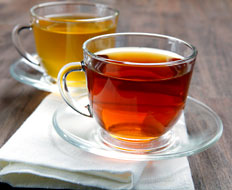Today, I bring you two inspirational tales of renewal, reinvention, and adaptation.
The first is the story of a formerly underappreciated and generally anonymous soul known botanically as Coffea Arabica, or Coffea canephora.
Growing up in California’s San Joaquin Valley, I knew this particular agricultural commodity exclusively as Folgers. Your first encounter with it may have come in the form of a certain Maxwell House, or perhaps a pair of Bros. named Hills.
The second story is that of Camellia sinensis, which may be more familiar to you as Lipton. According to the Tea Association of the USA, all tea is derived from this warm-weather evergreen, and it’s the degree to which its leaves are or aren’t oxidized in processing that determines whether the tea in your cup is of the green, black, or oolong variety.
Needless to say, both of these characters—tea and coffee—have been through quite a lot since their initial appearance on the middle-American scene. These days, specialty coffee roasters, high-end coffee appliances, and endlessly inventive coffee bars (including a handful of global chains) have turned the simple matter of running hot water through ground, dried beans into something approaching a higher art form.
Take LAMILL, the Los Angeles purveyor that’s made a big name for itself among connoisseurs by selling exotic beans grown in remote locales—high atop the mountains of Peru, for instance. As for tea, it’s becoming both a stand-alone sensation and a chameleonic mixer whose distinctive flavor, high health quotient, and sheer versatility is turning it into a go-to ingredient in everything from juice-based beverages to sodas and cocktails.
Both tea and coffee have certainly come a long way from their humble commercial beginnings here in the U.S. Let’s consider boths in turn and ponder just what sorts of things quick-serve operators might do to tap into each segment’s unique appeal.
Tea: Stealth Ingredient, Potent Infusion
For a sense of exactly how versatile tea can be, consider a few approaches taken by vastly different types of foodservice operations.
At the Tiger Lily Café in Port Jefferson, New York, you can order yourself a Chai Amore Soy Frappe, made with East India spice, wild raspberry, green tea, Tahitian vanilla, and mango. The Tea Smoothie at Soakology in Portland, Maine, features blueberry, ginger, strawberry-mango, or peaches and cream blended with other natural flavors and iced tea.
Then in that other Portland 3,000 miles away there is the tactic taken by the Teazone and the Camellia Lounge, an Oregon favorite. It’s a cocktail comprising jasmine green tea vodka, St. Germain elderflower liqueur, fresh lime, a splash of soda, and a fresh mint leaf garnish.
For operators seeking a provocative way to introduce new variety and excitement into standard-issue beverages, tea clearly offers opportunities to turn over a new leaf, as Jamba Juice and Caribou Coffee have discovered with their Hot Blends teas and Tea Latte Infusions, respectively.
Sonic has gotten in on the act with its cranberry and blackberry iced tea offering. And don’t forget the impressive variety of creative options now available on store shelves. Today, there are start-ups and established brands alike using infusions ranging from hibiscus, passion fruit, the South American super fruit Maqui berry, and botanicals such as lemongrass, rosehips, tarragon, and chamomile.
A Quicker Picker-Upper
When it comes to coffee, specialization and customization are definitely the orders of the day. K-Cups, those increasingly popular, individual, vacuum-sealed portions made popular by Keurig, offer a window on the future of coffee. You can bet that as consumers continue embracing the idea of a single cup of coffee made just for them, the notion will go from a novelty to an expectation.
The days of the office pot of warmed-over, generic coffee are numbered, and many quick-serve and fast-casual operators have already sensed that higher quality and the ability to offer an individualized coffee experience are key to boosting transactions and checks, particularly during the morning hours.
Fortunately for the adventurous operator, there remain many variations that have yet to be explored in most mainstream U.S. environments. In several North African and Middle Eastern countries, coffee spiked with cardamom and served almost as a thick sludge is standard fare.
That particular approach may not work for chain restaurants, but Spanish-style café con leche just might: What’s not to like about strong coffee served with steamed, but unfoamed, milk? Or maybe a French café crème, featuring regular coffee with hot milk that turns the entire works an appealing light tan color?
Canadians swarm to Tim Hortons and its Double-Double formulation, featuring two creams and two sugars.
And Latin Americans, who as a group drink a tremendous amount of coffee, often enjoy Café Americanos, essentially pure espresso leavened with a little hot water.
These ideas represent just the tip of the iceberg in terms of what can be done with coffee and tea. What’s clear is that the possibilities are many and varied.









